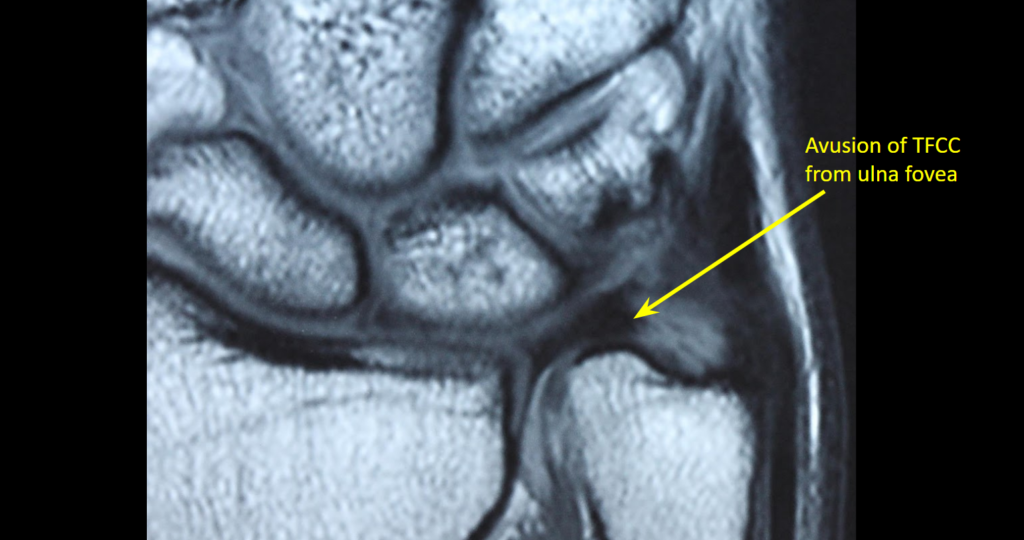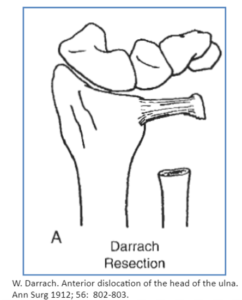Triangular Fibrocartilage Complex Injury
What is Triangular Fibrocartilage Complex (TFCC)?
The Triangular Fibrocartilage Complex (TFCC) is a region between your radius and ulna, the forearm’s two major bones. The TFCC consists of a variety of tendons, ligaments, and cartilage connected to the extensor carpi ulnaris. When gripping an object or rotating the forearm, it aids wrist movement and stabilizes the forearm bones.
The TFCC also serves as a cushion between the ulna’s distal end and the small bones of the wrist (triquetrum and lunate). Some individuals are predisposed to TFCC injuries due to a congenital anomaly called ulnar variance, where the ulna is longer than the radius (the bones that make up the forearm).

Causes of TFCC Injury
The following factors increase a person’s risk of developing a triangular fibrocartilage complex TFCC injury:
Age: As a person gets older, the risk of sustaining TFCC tears increases. This may be due to normal wear and tear or because the body’s ability to heal TFCC degradation deteriorates.
Chronic Inflammation: Inflammatory diseases like rheumatoid arthritis and gout can cause wrist damage over time. TFCC tears were observed in 38.9% of people with severe rheumatoid arthritis, according to a small retrospective survey.
Participation in Sports: Wrist injuries are most common in athletes who play baseball, basketball, or tennis. According to research, the hand or wrist is involved in around 25% of all sports injuries.
How does TFCC Injury occur?
There are two forms of TFCC tears, traumatic and degenerative.
1. Traumatic
Falling on an outstretched hand, extreme arm rotation or a blow to the wrist are common causes of the traumatic injury. Athletes, particularly those who use a racquet, bat, or who place pressure on their wrists, are at risk.
2. Degenerative
Degenerative tears grow as the cartilage wears down with time and with age. This state can be accelerated by repeated pronation and squeezing. Tears may be caused by minor trauma or force.
TFCC Injury Symptoms
The main symptom of a TFCC tear is ulnar sided wrist pain, though you might also feel pain throughout your entire wrist. The pain may be constant or only appear when you move your wrist or apply pressure to it.
Other symptoms of a TFCC tear include:
- A clicking or popping sound when you move your wrist
- Swelling
- Instability
- Weakness
- Limited motion
- Tenderness
Diagnosing TFCC Injury
Ulnar Fovea Sign.
This test is probably the most sensitive and specific test for TFCC injuries. It is performed with the patient seated across from the surgeon, and his or her elbow placed onto the table, flexed to 90 degrees with the hand upright and the ulnar aspect of the wrist facing directly at the surgeon. The surgeon stabilizes the wrist with one hand whilst with the tip of the thumb of the opposite hand, the surgeon pushes into the soft region at the ulnar aspect of the wrist, just above the ulnar styloid. If this is tender, the test is positive and indicates a possible injury of the TFCC at the styloid and/or foveal attachment sites.
Radioulnar ballotment
Though this physical exam is of low clinical value, doctors still use it to assess radioulnar joint stability. The test begins with the patient’s forearm stretched out on a table in neutral rotation. The examiner stabilizes the distal radius (thumb side of the hand) and the hand as one unit. Simultaneously, the examiner bend-grasps the ulnar side of the hand then forces it in the dorsal and palmar direction relative to the radius.
This procedure is repeated in relative supination and pronation. The stability in the possibly affected hand is compared to the unaffected hand. Laxity, as well as an abrupt reduction in the patient’s pain symptoms, indicates a positive test.
Piano key sign
The Piano-Key Sign Test is a physical examination for assessing wrist stability. The doctor supports the wrist in pronation. The ulnar side of the hand is stabilized in the neutral spot, and weight is applied to the ulnar head. If the ulnar head returns to its anatomic location after the stress is removed, the result is positive.
The patient experiences discomfort when attempting to raise the examining table with the hand flat on the underside of the table. This action causes a load over the TFCC with the wrist supinated and stretched, inducing dorsal impingement, which helps detect a peripheral, dorsal TFCC tear.
Ulnocarpal stress test
To perform this test, the doctor uses their left hand to stabilize the patient’s arm. The elbow is flexed with the hand directed upwards at angle 90 degrees. The examiner holds the elbow in their left hand and the hand in their right. The wrist is then placed in full ulnar deviation with the examiner’s hand providing axial load while simultaneously pronating and supinating the forearm. While the examiner does this, they look out for provocation of ulnar-sided wrist pain which indicates a positive test.
Press test
The patient sits in a chair with armrests and, with hands grasping the armrests, attempts to push himself up. This typically causes intense pain in a patient with a TFCC tear.
Lunotriquetral (LT) ballotment to rule out LT ligament tears
The lunate is translated anterior-posterior with the triquetrum stabilized by putting the index finger on one hand and your thumb on the other in this test.
Assess for pain, laxity, and crepitus, indicating a positive test.
Pisotriquetral grind test to rule out PT joint dysfunction
To perform the pisotriquetral grind test, place the pisiform between the thumb and index finger and move it from ulnar to radial while moving the wrist in different flexion and radioulnar deviation positions to mimic the patient’s discomfort or crepitus.
TFCC Injury Treatments
Non-Operative (Trial of non-surgical management)
- Activity modification to reduce strain on the wrist
- Splinting (Muenster-type splint, at least six weeks)
- Non-steroidal Anti-inflammatory Drugs: To reduce the pain and swelling
- Hydrocortisone and Lignocaine (cortisone) injections
Operative
Arthroscopic
The surgeon makes several minor incisions around the wrist joint and implants a miniature camera (called an arthroscope) to inspect the ligaments and measure the impairment in this minimally invasive operation. Cleaning the edges of the injury and removing damaged tissue (called a debridement) or repairing of the site is performed with minute equipment.
If there is ulnar variance, the surgeon can excise the ulnar bone to the proper length. Arthroscopy provides a complete visualisation of the wrist without traumatising nerves or muscles. Patients report less pain and blood loss, as well as fewer complications and a quicker recovery time.
Open Surgery
In cases of severe or multiple TFCC tears, the surgeon may need to repair the injury with metal pins, screws, or other fixation devices. An open incision is required for this more intensive surgical treatment. If there is ulnar variance, the surgeon could need open surgery to shorten it. Open surgical techniques for this injury include:
- Darrach
- Darrach with Tenodesis
- Hemiresection-Interposition
- Sauve-Kapandji
- Ulna Head Replacement

TFCC Recovery Time
Recovery time for TFCC tears is about four to six weeks when they do not require surgical treatment. It may take anywhere from six weeks to several months to restore complete wrist function if surgery is needed.
Speak to our hand care team to find out if this is the medical condition you have at +65 6733 9093. Or book an appointment with our hand specialists for a consultation on your symptoms and treatment options.
